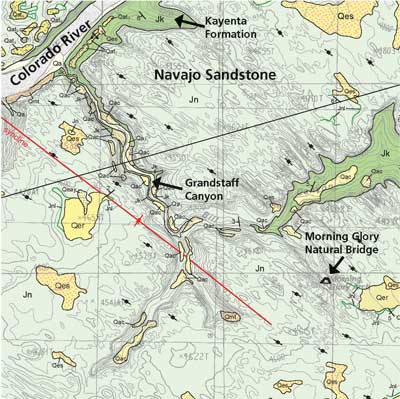Geology HAPPENINGS February 2018 |
||||||||||
| What’s in a Name? The Science Behind Rock Names By Allyson Mathis |
||||||||||
People who live or spend any time in Moab, even for a quick visit to canyon country, know the names. Navajo Sandstone. Entrada Sandstone. Chinle Formation. Organ Rock Shale. Trail descriptions in guidebooks refer to the rock layers. For example, the Moab Rim Trail follows ledges in the Kayenta Formation. And the White Rim Road in Canyonlands National Park literally sits atop the White Rim Sandstone. Many of the most-loved areas in southeastern Utah take their defining characteristics from the rocks exposed there. Arches National Park is best known for its natural arches carved into the Entrada Sandstone. The Slickrock Bike Trail exists only because of the distinctive Navajo Sandstone. The Island in the Sky is held up by the Wingate Sandstone and Kayanta Formation.
In geology, rock layers are known as “formations.” As with anything scientific, there is a full technical definition for the term. According to the North American Commission on Stratigraphic Nomenclature, the body responsible for overseeing the naming and classification of rock units, a formation is:
2. Stratigraphic position. Stratigraphy is the branch of geology that studies the order and relative position of rock layers, also known as strata. Rock layers are deposited through time sequentially and are always found in the same order. The Chinle Formation was deposited before the Wingate Sandstone and is always found below the Wingate cliffs. The Kayenta Sandstone sits on top of the Wingate and is in turn overlain by the Navajo Sandstone. 3. Mappable at the earth’s surface or traceable in the subsurface. Geologic maps show what rock layers are exposed on the surface along with related geologic information using color codes and symbols. The Navajo Sandstone is represented on the Geologic Map of the Moab Quadrangle using a light green color and the symbol “Jn,” which indicates Jurassic-aged Navajo Sandstone.
In biology, each species that has been scientifically-named has a type specimen archived in a museum. Because it is not possible to house an entire outcrop of a rock layer in a museum, type sections serve the same role that biological type specimens do. Type sections for rocks found near Moab include Entrada Point in the San Rafael Swell and near Kayenta, Arizona. The Navajo Sandstone, which is exposed all around Moab (in Arches and Canyonlands national parks, in Sand Flats and Behind the Rocks), as well as in Zion and Capitol Reef, provides an excellent example of what a formation is. The rock type is sandstone, made up of sand grains that have been cemented together after deposition in large dunes in a sand sea (or erg). It was first described based on exposures of the sandstone in Navajo Nation. The sand dune field was located in what is now Utah and northern Arizona when the climate was even drier, winds were more constant and stronger, there was a large supply of sand and dinosaurs roamed the earth. .
|




